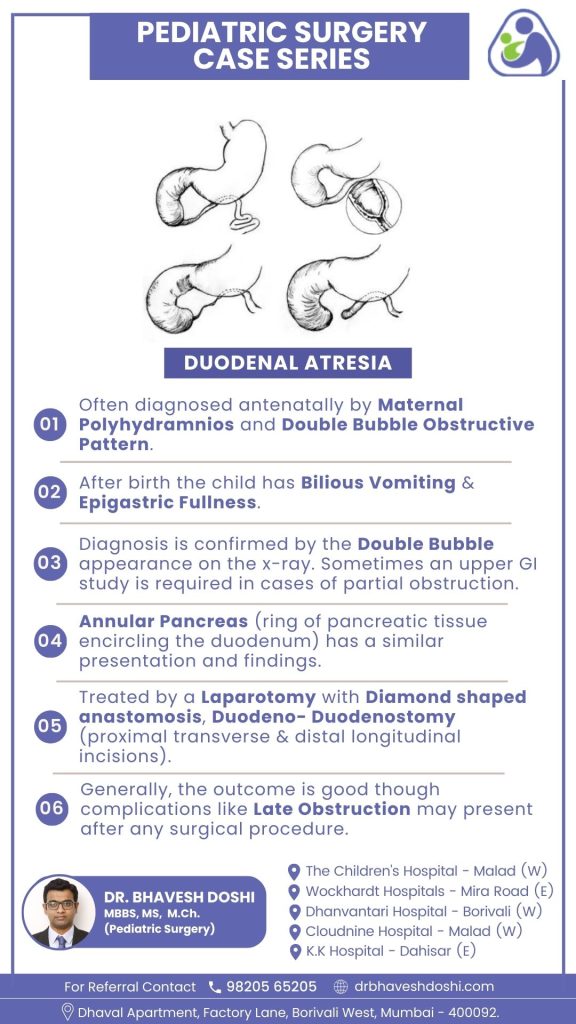Duodenal Atresia
Duodenal atresia is a congenital condition resulting in intestinal obstruction, presenting with either bilious or non-bilious vomiting within the initial 24 to 38 hours of neonatal life, often following the first oral feeding. This condition is notably associated with in-utero polyhydramnios, an excess accumulation of amniotic fluid during pregnancy. Duodenal atresia stands as one of the prevalent causes of fetal bowel obstruction, emphasizing its significance in neonatal healthcare. The characteristic symptom of vomiting shortly after birth signals the need for prompt diagnosis and intervention to address this congenital intestinal obstruction.
What is the diagnostic method for Duodenal atresia?
Antenatal Diagnosis:
Maternal polyhydramnios and a double bubble pattern in fetal imaging aid in identifying duodenal atresia during pregnancy, allowing for anticipatory planning and postnatal care.
Postnatal Presentation:
Infants with duodenal atresia display distinct symptoms, including bilious vomiting and epigastric fullness, signaling the need for immediate medical attention and diagnosis.
Diagnostic Confirmation:
X-ray imaging reveals the hallmark “double bubble” appearance, confirming the diagnosis of duodenal atresia and guiding subsequent management decisions.

Additional Diagnostic Measures:
In cases of partial obstruction or uncertainty, an upper gastrointestinal study may be employed for a detailed assessment, ensuring a comprehensive understanding of the obstruction’s nature.
Annular pancreas, a condition involving a ring of pancreatic tissue encircling the duodenum, shares similarities in presentation with duodenal atresia. Distinguishing between the two conditions may require comprehensive diagnostic evaluation, including imaging studies and clinical assessment.
What is the Treatment Approach for Duodenal atresia?
Laparotomy with Diamond-Shaped Anastomosis
Duodenal atresia is typically addressed through a surgical procedure known as laparotomy. The chosen technique involves creating a diamond-shaped anastomosis, specifically a Duodeno-Duodenostomy. This procedure entails making both proximal transverse and distal longitudinal incisions on the duodenum, allowing for the reconnection of the obstructed segments.
Duodeno-Duodenostomy
During the surgical intervention, the surgeon performs a Duodeno-Duodenostomy by making precise incisions on the duodenum. The proximal transverse incision and the distal longitudinal incision create a diamond-shaped opening, facilitating the restoration of the continuity of the duodenum. This meticulous approach aims to address the congenital obstruction and restore proper intestinal flow.
In general, the outcome of surgical intervention for duodenal atresia is positive. The laparotomy with Duodeno-Duodenostomy effectively resolves the obstruction, allowing for improved digestive function. Infants typically experience relief from the symptoms associated with duodenal atresia.
What are the Complications If not treated early?
While the overall outcome is favorable, complications may arise, and one notable concern is the potential for late obstruction. Late obstruction can manifest after any surgical procedure, posing a challenge in the postoperative period. Close monitoring and prompt medical attention are essential to address and manage any complications that may arise during the recovery phase.
Understanding the intricacies of the surgical approach, recognizing the potential for positive outcomes, and remaining vigilant for possible complications contribute to comprehensive care for infants undergoing laparotomy with Diamond-Shaped Anastomosis for duodenal atresia. Early intervention and attentive postoperative care are crucial elements in ensuring the best possible results for affected infants.



